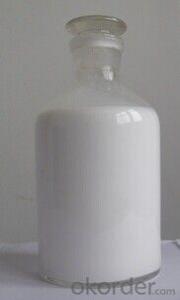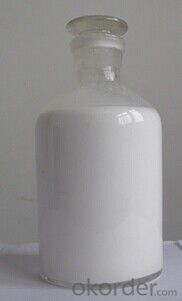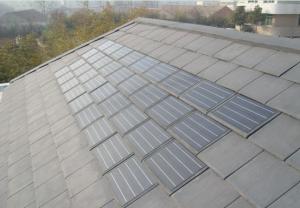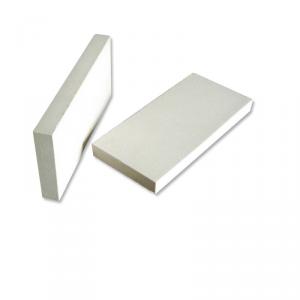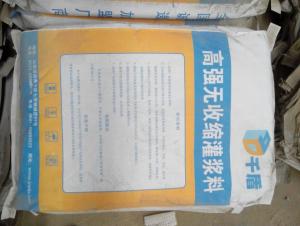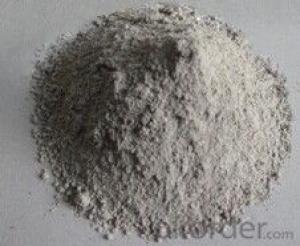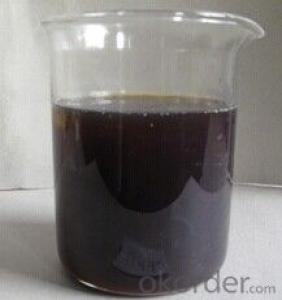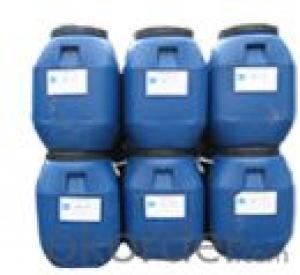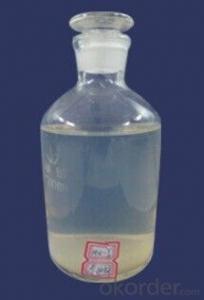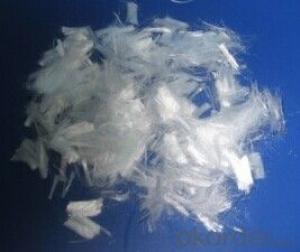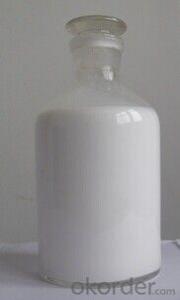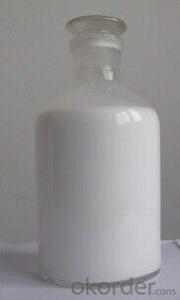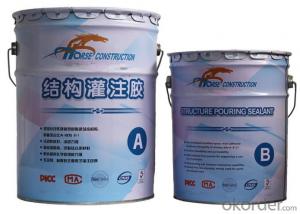Sleeper Mould Release Agent (TS)
- Loading Port:
- China Main Port
- Payment Terms:
- TT OR LC
- Min Order Qty:
- -
- Supply Capability:
- -
OKorder Service Pledge
OKorder Financial Service
You Might Also Like
Sleeper Mould Release Agent (TS)
The product is widely used in processing track sleepers, bridges, pipes, power-line poles, metro, tunnels, bridge-piers, cylinder cement casts.
APPLICATION METHOD
1. Mixing proportion
1) When the first time using this product, to avoid the mixed mould releasing liquid being contaminated during application period, any dirt inside all the facilities which are used to mix should be completely cleaned including container box, pressure tank, pipeline or spray nozzle. To ensure an average spray, Spray nozzle should be examined regularly. The pressure tank should be cleaned every three months to prevent the concentration of mould release being diluted by the accumulated water inside the tank.
2) Use clean running water to mix the mould release. In high temperature season, add running water directly to mould release agent according to recommended ratio. After adequate mixing and totally dissolved, the liquid is ready to use.
3) In winter or cold weather, heat three quarter of needed water to fifty degree by steam (the steam will generate one quarter of condensed water in the heating process), then add mould release agent at required ratio. Fully stirred, the liquid will be ready to use.
Notes, when mixing mould release liquid, it is prohibited to directly mixing it with steam. Leakage and dropping should be avoided too.
Recommendation: If possible, a low-speed agitator may be added to the mixing cabinet. Keep it stirring constantly. In this way, the effective ingredient in the mould release liquid will be used better. Time and effort will be saved and water proportion will be increased.
4) Water proportion: Initially, the ratio can be 1:2 (one kilogram mould release agent against two kilogram water). Then according to the cleanness and smoothness of the mould used, the water proportion can be increased to 1:2.5, 1:3, 1:3.5, 1:4.
5) When using this product for sleeper with pre-buried iron block installation, the water application ratio should be controlled less than 1:1.5.
2. Spraying method
1) New moulds or moulds with formed scale should be de-oiled or cleaned. For moulds rusted seriously should be polished, de-rusted, and cleaned. In such way it takes shorter time for mould release agent to moist the mould, and the appearance of sleeper won’t be affected.
2) The cold mould should be preheated prior to using. Cold mould without preheated should use less water in order to increase the concentration of mould release liquid, and to prevent the mould from sticking.
3) To achieve a mist spraying effect, before starting, ensure the pressure in the pressure tank not lower than 0.4MPa.
4) To ensure best spray, the spray nozzles (four pieces will be ideal) should to be adjusted to make sure the position of spray nozzles, the spray angle match the position of mould to be sprayed. After sprayed, if there is uneven spray or spotted spray on the side of the mould, manually make-up brushing is necessary. If there is some accumulated liquid on the bottom of the mould, use brush to spread the liquid to the sides of the mould to prevent the appearance of the sleeper being affected.
CHARACTERISTICS
1. Visual appearance: ivory-white with slight fragrance, fine texture like fresh milk
2. High purity and grease content, high temperature resistance, low freezing point, inflammable.
3. Good anti-corrosive, stable quality, anti-oxidation. Able to catalyze water molecule.
4. Easy to use, no pollution, no poison, clean and sanitary.
According to the test report, it is non-explosive, non-oxidation, inflammable, non-corrosive, non-poisonous, and non-radiation.
ADVANTAGES
1. Effective mould lease: it keeps the concrete products original color and reduces bubbles. It also covers up the bubbles and air holes. Compared with oil release, it reduces two thirds holes and bubbles on the same area to make the s surface smooth and neat
2. Effective rain-proof: with the isolation layer formed, there is no effect from rain.
3. No corrosion and contamination to the surface of concrete, mould, rubber sealant and rubber shoes.
4. After mould released, there is few dirt and sand on the mould, which makes it easy to clean. The character of corrosion - inhabitation to metal mould can keep metal brightness, save cleaning effort, and extend mould service life. Under urgent condition, it has high efficiency. Mould releasing, cleaning, spreading and spraying, setting up can be operated simultaneously.
5. Easy to mix with water and easy to use. After spraying or brushing on the mould, when the isolation layer is formed and it is ready to cast the concrete.
6. Cost-effective. The cost is 1 to 2 times lower than using oil and other release product.
STORAGE
The product should be stored closely and not to be exposed under sun and rain. Quality warranty is 3 years. If no storage condition on the construction site, it should be sledded and ventilated in summer. In the cold region, anti-freezing measure should be taken. For example, keep it in storage room with heating system or curing place in sleeper workshop
TECHNICAL REQUIREMENT AND TESTING PARAMETERS
The testing standard is for mould release agent produced from crude oil after fading the color with white earth and mixed with catalyst, preservative, anticoagulant and anti-oxidation.
Testing Item | Quality index | Testing method | |
Visual appearance | ivory-white paste | visaually | |
color | ivory-white | visaually | |
texture | fineness | visaually | |
odour | nonirritant | visaually | |
kinematic viscosity (V40) | (cst/s) | 17-23 | GB/T265 |
Solidification point0C | No lower than | -100C | GB/T510 |
PH Value | (PH value) | 7—8 | GB/T259 |
Grease content | % | TF-7B≥85 | GB/T512 |
stearic acid value | (mg KOH/g) | ≥1.9 | GB/T264 |
Corrosion inhibitation: (room tempreture, distilled water,24h,1 grade C.I) | 9% density | Singal layer without rust | SH/T0080 |
Surface tension | Dyh/cm | ≤60 | GB/T6541 |
Resistance to elevated temperatures | No melting to isloation layer | 900C | Curing under elevated tempratures |
- Q: Bathroom wall brush flexible waterproof, stick wall bricks easy to fall off after it? Is not tiling cement to add 901
- Go to the market to buy tiles,Can not fall !
- Q: Lime in the building materials in the role and the main application
- Lime condensation hardening slow, low strength, poor water resistance
- Q: Brick and concrete structure and frame structure in the force system, the use of building materials and the scope of the three aspects of the difference. Thank you ~ ~ very anxious
- Masonry structure: gravity load transfer floor, roof panel → wall → foundation → foundation → crust
- Q: Who knows the inorganic insulation mortar and the previous material What is the difference?
- The main material is vitrified microbeads, there are many manufacturers of the use of expanded perlite mixed with them, the particles are not uniform, the density is not enough, the late anti-cracking and water seepage
- Q: Home to warm backfill, to warm the requirements of the back to fill with the strength of the C15 of the bean concrete, but the warm work that with 13 chicken gnawing flone glycoside sulfonate bag Han Li bag cement, 1 gravel (melon stone 5mm), 2 Sand concrete (gravel and sand ratio and C15 gap between the larger), concrete mixing station also tend to a reasonable proportion, said the local warm backfill is the proportion of which proportion I should require backfill concrete, confused? More
- After the completion of the completion of the completion of the completion of the completion of the end of the building, the use of cement label . concrete composition Weight: cement: sand: melon pieces (beans): water = 1.25: 3: 2 : 0.4
- Q: 18 layers of high-rise, frame-shear structure, the northern coastal areas, the external walls of real stone . wall materials with no burning hollow brick good? Do you want to use a red brick or a gray brick on every floor when you build a wall? If the direct puzzle does not have any impact, will not moisture it? What are the consequences of living in the world? . external wall insulation What is more popular in the north, the use of insulation board (such as polystyrene board) and insulation mortars have their own advantages and disadvantages? Also do the external insulation, the house is also used for insulation it? Is not finished pouring the wall after leveling is the rough room? More
- 2 What kind of insulation room according to the state of the insulation requirements and materials can meet the requirements to meet Polystyrene board thin plaster can engage in energy-saving 65% or even higher requirements, and most of the foreign use, so more popular In addition, you said that the insulation mortar should be a kind of glass beads insulation mortar itself after the construction of the insulation effect, the mortar can achieve the effect of insulation is limited, if you meet the higher insulation requirements are either not applicable or Will be too thick construction can be But the efficiency of insulation, far less than the polystyrene foam insulation board For the external walls of the insulation, of course, the more insulation layer is more conducive to energy conservation, if conditions permit, do naturally good Generally speaking, the design will only design one of them, very few buildings inside and outside the building insulation are done inside and outside Pouring the walls have to build a layer of interface mortar, which can not be considered leveling, so that the basic can be the main work, and that is rough If the leveling is better
- Q: I would like to check, I would like to ask C. C20 with more than how to check, there are mortar M5 cement, mixed mortar how to check, the need for any material.
- Mortar is mainly sent to the cement and sand; and then to the test unit to fill the next order, indicating the design strength and consistency there are structural parts; if you have added mortar or admixture and the like, to refer to the added material certificate above The best proportion to add, the general inspection when the inspection unit will require a copy of a certificate
- Q: What is the wall gray? Is the mortar king or mortar the same?
- Improve the mortar of the workability, water retention, cohesive force, so that the cement can maximize the hydration, thereby enhancing the strength of mortar, construction performance and effectively reduce the floor ash; completely avoid the gray paste (powder) after the construction of the second water The emergence of the burst of particles, cracks, for the construction of the surface to create a good base surface At the same time compared the use of traditional gray paste (powder) to reduce the cost of about 30% of the material Is in line with international low-carbon, energy-saving trend was environmentally friendly building materials
- Q: I expect a correct answer, not guess, the answer is best to have some evidence of the source, thank you
- Source of inspection (decoration) General plaster is very clear The other quota preparation issued earlier than the "plaster mortar with the rules" JGJ / T220-2010 "Plaster mortar with the rules" JGJ / T220- is released 2010-07- 2011-03-01 implementation Plastering mortar from then on the volume ratio compared to the quality ratio Fixed or old The other with how you with cement lime plaster mortar, strength grade: M2 M M7 M10 will come to the 1: 1: 6 quality ratio Do not believe you enter the formula to seek
- Q: Insulation putty can be used alone as an external wall insulation material? Whether the external wall insulation putty can replace the external wall mortar
- First of all, you can not replace the insulation material insulation, and many products in the development process slowly with the time will reflect their own shortcomings, insulation board has now been recognized by the state, and Insulation putty is not able to achieve the quality of the real ability to quantify. Insulation board normal life can reach 20 years, up to 30 years, the life of insulation putty is also 20 years, high water resistance can reach 30 years. Insulation putty can not be too thick construction, too thick easy to crack off, large area with the visual plane effect is poor. And the insulation board in the thickness of the greater arbitrariness, the insulation board in the construction of Ji Ji reclamation killing the old ghost tame handmade foam can make a large area of ??the wall is more smooth, of course, relatively heat putty, the construction cost is higher. But the two are complementary in the building, a small area more difficult to build the edge of the construction site, available insulation putty, large selection of insulation board, of course, for some of the insulation requirements are not high can also use insulation putty. The insulation requirements of a little more choice of insulation board. Insulation putty can replace the mortar, the premise is not to do other work above the putty. I hope my answer will help you!
Send your message to us
Sleeper Mould Release Agent (TS)
- Loading Port:
- China Main Port
- Payment Terms:
- TT OR LC
- Min Order Qty:
- -
- Supply Capability:
- -
OKorder Service Pledge
OKorder Financial Service
Similar products
Hot products
Hot Searches
Related keywords
